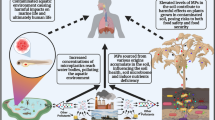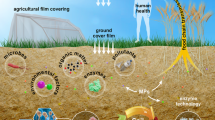Abstract
The aim of the present study was to determine the influence of light soil fertilization using sewage sludges or composts on soil toxicity for three plant species (Lepidium sativum, Sorgo saccharatum, and Sinapis alba) and crustaceans (Heterocypris incongruens). The results obtained were compared to the polycyclic aromatic hydrocarbon (PAHs) content as a potential toxicity factor. The PAH content in soils fertilized with sludges was proportional to the dose applied. Soil fertilization with the studied materials negatively influenced plant growth and development. The negative influence was clearer in the case of sewage sludges than composts. Both sludges and composts significantly influenced H. incongruens mortality. However, the influence of sludges and composts on H. incongruens growth did not exceed 20%. The EC50 and LC50 values calculated on the basis of toxicity parameters showed that H. incongruens was characterized by a higher sensitivity to sludges and composts than most of the plants. L. sativum was characterized by the lowest EC50 values among all plants. No significant relationships between sewage sludge or compost toxicity and their PAHs content were observed.



Similar content being viewed by others
References
Alvarenga, P., Palma, P., Gonçalves, A. P., Fernandes, R. M., Cunha-Queda, A. C., Duarte, E., et al. (2007). Evaluation of chemical and ecotoxicological characteristics of biodegradable organic residues for application to agricultural land. Environment International, 33, 505–513.
Aparicio, I., Santos, J. L., & Alonso, E. (2009). Limitation of the concentration of organic pollutants in sewage sludge for agricultural purposes: A case study in South Spain. Waste Management, 2009, 1747–1753.
Blanchard, M., Teil, M. J., Ollivon, D., Legenti, L., & Chevreuila, M. (2004). Polycyclic aromatic hydrocarbons and polychlorobiphenyls in wastewaters and sewage sludges from the Paris area (France). Environmental Research, 95, 184–197.
Chial, B., & Persoone, G. (2003). Cyst-based toxicity tests XV—Application of ostracod soild-phase microbiotest for toxicity monitoring of contaminated soils. Environmental Toxicology, 18, 215–222.
Domene, X., Alcañiz, J. M., & Andrés, P. (2007). Ecotoxicological assessment of organic wastes using the soil collembolan Folsomia candida. Applied Soil Ecology, 35, 461–472.
Dubova, L., & Zarina, D. (2004). Application of toxkit microbiotests for toxicity assessment in soil and compost. Environmental Toxicology, 19, 274–279.
Epstein, E. (2003). Land application of sewage sludge and biosolids. Boca Raton: Lewis.
Evanylo, G. K., & Daniels, W. L. (1999). Paper mill sludge composting and compost utilization. Compost Science & Utilization, 7, 30–39.
Fjällborg, B., Ahlberg, G., Nilsson, E., & Dave, G. (2005). Identification of metal toxicity in sewage sludge leachate. Environment International, 31, 25–31.
Fritz, J. (1999). Okotoxizitaat biogener Werkstoffe wahrend undnach ihrem biologische Abbau. AbteilungUmweltbiotechnologie des Interuniversitaren Forschungsinstitutsfur Agrarbiotechnologie, IFA.
Fuentes, A., Lloréns, M., Sáez, J., Aguilar, M. I., Pérez-Marín, A. B., Ortuño, J. F., et al. (2006). Ecotoxicity, phytotoxicity and extractability of heavy metals from different stabilised sewage sludges. Environmental Pollution, 143, 355–360.
Hamdi, H., Manusadzianas, L., Aoyama, I., & Jedidi, N. (2006). Effects of anthracene, pyrene and benzo[a]pyrene spiking and sewage sludge compost amendment on soil ecotoxicity during a bioremediation process. Chemosphere, 65, 1153–1162.
Harms, H. H. (1996). Bioaccumulation and metabolic fate of sewage sludge derived organic xenobiotics in plants. Science of the Total Environment, 185, 83–92.
Harrison, E. Z., Oakes, S. R., Hysell, M., & Hay, A. (2006). Organic chemicals in sewage sludges. Science of the Total Environment, 367, 481–497.
Ju, J.-H., Lee, I.-S., Sim, W.-J., Eun, H., & Oh, J.-E. (2009). Analysis and evaluation of chlorinated persistent organic compounds and PAHs in sludge in Korea. Chemosphere, 74, 441–447.
Kapanen, A., & Itävaara, M. (2001). Ecotoxicity tests for compost applications—Review. Ecotoxicology and Environmental Safety, 49, 1–16.
Maliszewska-Kordybach, B., Smreczak, B., & Klimkowicz-Pawlas, A. (2009). Concentrations, sources, and spatial distribution of individual polycyclic aromatic hydrocarbons (PAHs) in agricultural soils in the Eastern part of the EU: Poland as a case study. Science of the Total Environment, 407, 3746–3753.
Misztal, M., Smal, H., & Wójcikowska-Kapusta, A. (1997). Lithosphere and protection. Lublin: Wydawnictwo AR.
Murillo, J. M., Cabrera, F., Lopez, R., & Martin-Olmedo, P. (1995). Testing low quality urban composts for agriculture: Germination and seeding performance of plants. Agriculture, Ecosystems & Environment, 54, 127–135.
Oleszczuk, P. (2008a). Heterocypris incongruens as a tool in estimation of sewage sludges toxicity. Environmental Toxicology and Chemistry, 27, 864–873.
Oleszczuk, P. (2008b). The toxicity of composts from sewage sludges evaluated by direct contact tests Phytotoxkit and Ostracodtoxkit. Waste Management, 28, 1645–1653.
Oleszczuk, P. (2009). Testing of different plants to assess influence of physico-chemical properties, heavy metals and polycyclic aromatic hydrocarbons content in municipal sewage sludges. Environmental Toxicology, in press.
Oleszczuk, P., & Baran, S. (2004). Application of solid-phase extraction to determination of polycyclic aromatic hydrocarbons in sewage sludge. Journal of Hazardous Materials, 113, 237–245.
Oleszczuk, P., & Baran, S. (2005a). Influence of sewage sludge amendment on leaching of individual polycyclic aromatic hydrocarbons in plot experiments. Polish Journal of Environmental Studies, 14, 491–500.
Oleszczuk, P., & Baran, S. (2005b). Polycyclic aromatic hydrocarbons content in shoots and leaves of willow (Salix vinimalis) cultivated on the sewage sludge-amended soil. Water, Air, and Soil Pollution, 168, 91–111.
Oleszczuk, P., & Pranagal, J. (2007). Influence of agricultural land use and management on the contents of polycyclic aromatic hydrocarbons in selected silty soils. Water, Air, and Soil Pollution, 184, 195–205.
Pascual, J. A., Ayuso, M., Garcia, C., & Hernandez, T. (1997). Characterization of urban wastes according to fertility and phytotoxicity parameters. Waste Management Research, 15, 103–112.
Ramírez, W. A., Domene, X., Ortiz, O., & Alcañiz, J. M. (2008). Toxic effects of digested, composted and thermally-dried sewage sludge on three plants. Bioresource Technology, 99, 7168–7175.
Schnaak, W., Küchler, T., Kujawa, M., Henschel, K.-P., & Süßenbach, D. (1997). Organic contaminants in sewage sludge and their ecotoxicological significance in the agricultural utilization of sewage sludge. Chemosphere, 35, 5–11.
Stevens, J. L., Northcott, G. L., Stern, G. A., Tomy, G., & Jones, K. C. (2003). PAHs, PCBs, PCNs, organochlorine pesticides, synthetic musks and polychlorinated n-alkanes in UK sewage sludge: Survey results and implications. Environmental Science & Technology, 37, 462–467.
Tao, S., Guo, L. Q., Wang, X. J., Liu, W. X., Ju, T. Z., Dawson, R., et al. (2004). Use of sequential ASE extraction to evaluate the bioavailability of DDT and its metabolites to wheat roots in soils with various organic carbon content. Science of the Total Environment, 320, 1–9.
Van Reeuwijk, L.P. (1995). Procedures for soil analysis. In L.P. Van Reeuwijk (ed.), International Soil Reference and Information Centre (ISRIC), Food and Agriculture Organization of the United Nations, Wageningen, Netherlands.
Walter, I., Martínez, F., & Cala, V. (2003). Heavy metal speciation and phytotoxic effects of three representative sewage sludges for agricultural uses. Environmental Pollution, 139, 507–514.
Wilke, B.-M., Riepert, F., Koch, C., & Kühne, T. (2008). Ecotoxicological characterization of hazardous wastes. Ecotoxicology and Environmental Safety, 70, 283–293.
Wong, J. W. C., Li, K., Fang, M., & Su, D. C. (2001). Toxicity evaluation of sewage sludge in Hong Kong. Environment International, 27, 373–380.
Author information
Authors and Affiliations
Corresponding author
Electronic supplementary material
Below is the link to the electronic supplementary material.
Table S1
PAHs concentration in soil, sewage sludge and compost samples used in the experiment (DOC 53 kb)
Table S2
PAHs concentration in sewage sludge or compost-amended soil (DOC 59 kb)
Table S3
Correlation analysis between toxicity parameters and polycyclic aromatic hydrocarbons content (DOC 58 kb)
Rights and permissions
About this article
Cite this article
Oleszczuk, P. Toxicity of Light Soil Fertilized by Sewage Sludge or Compost in Relation to PAHs Content. Water Air Soil Pollut 210, 347–356 (2010). https://doi.org/10.1007/s11270-009-0257-8
Received:
Accepted:
Published:
Issue Date:
DOI: https://doi.org/10.1007/s11270-009-0257-8




